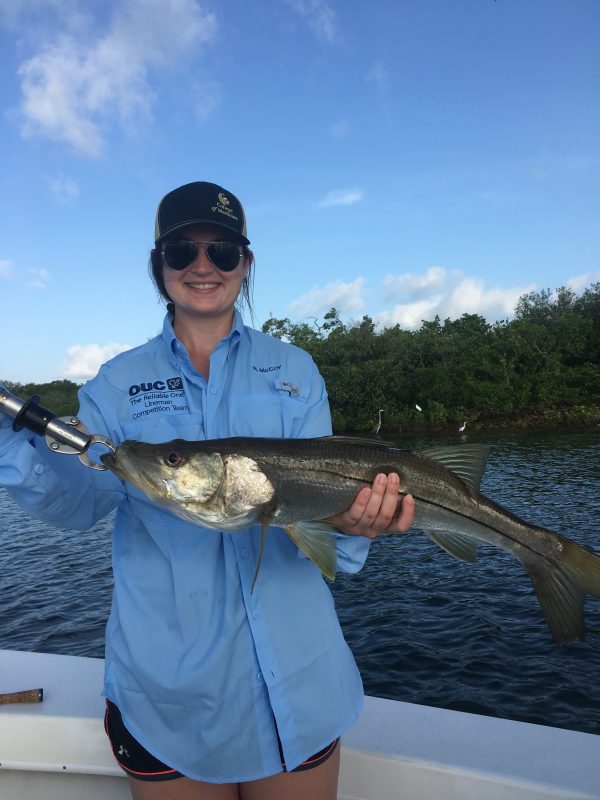Fishing around Anna Maria Island remains consistent despite some of the hottest weather of the summer season so far.
With temperatures in the mid to upper 90s and heat indices in the range of 110 degrees, you may want to time your fishing excursions around the cooler periods of the day. Fishing from dawn until 9 or 10 am and again from late evening until after sunset will be much more comfortable even if the temps are only slightly cooler.
You’ll notice, especially while inshore fishing, that the fish will react better during these cooler times, too. And, remember to drink plenty of water while outdoors as to not suffer from heat stroke or dehydration. These symptoms can ruin a day of fishing in a hurry as well as make you extremely uncomfortable.
Those anglers willing to brave the heat are experiencing excellent fishing in the back country of Tampa Bay. Casting live shiners around mangrove shorelines and oyster bars is yielding good action on catch-and-release snook. Catch-and-release redfish are present in these areas and are mixed in with the snook bite. Fishing deeper grass for catch-and-release spotted seatrout is also a good bet. Slot-size trout are in decent numbers. Lucky anglers are even catching a few over-slot fish. You can also experience Spanish mackerel and mangrove snapper on the deeper grass which is good if you’re looking for a couple of fish to take home for dinner.
Offshore fishing is in full swing with very positive reports of American red snapper, mangrove and yellowtail snapper. Fishing depths of 60-100 feet of water seems to be the “sweet spot” for these snappers as well as a variety of other species including red snapper, permit and African pompano.
On a more serious note, I regretfully feel the need to report what I suspect is a bloom of blue green algae. On a recent trip up around the area where the Braden River intersects with the Manatee River, I noticed something I thought I would never occur in our area. The waters in both of these rivers are brackish — they are part saltwater and part freshwater. A telltale sign of being brackish water is its color. Typically, it’s a dark color ranging from light amber to almost something similar to iced tea. Well, what I witnessed was not this at all. In fact, the water had changed to a color of neon green.
Now, I don’t claim to be a scientist of marine biologist. I’m just a humble charter fisherman from Bradenton. That being said, I still know what I saw. After further inspection, I can’t come up with another theory.
Blue green algae, also known as cyanobacteria is an algae bloom that occurs in marine, fresh and brackish water habitats. Factors that contribute to this algae bloom include warm temperatures, reduced water flow and circulations and especially an increase in nutrients. I know that the warm water and reduced water flow exist in the affected area of the Braden River, but after 40 years of living in Bradenton, I’ve never seen this phenomenon. The other contributor is where I am intrigued. An increase in nutrients.
Well, phosphorus is the nutrient that triggers blue green algae to thrive. And phosphorous is in fertilizer. And furthermore, development has spread to these areas of the Braden and upper Manatee Rivers in exponential numbers in the past 10 years. Could this be the contributing factor? I don’t know. I do know that with the number of new housing developments and a plethora of golf courses it seems to be a logical assumption. Those bright green lawns don’t get that way on their own.
This being said, I’m not trying to place blame on any one entity, but I do believe the writing is on the wall. Why is it that we’ve never seen blue green algae before and now after this surplus of populated areas around the Braden River we are experiencing a bloom.
Is it time to reexamine our laws and regulations referring to development of delicate areas where watersheds and estuaries exist? Are we forgetting that the pristine waters and lush flora and fauna are why we live in Florida? Without these, we are left with just “the heat.” And sure, Floridians don’t mind the heat so much, but it’s all of the beauty that surrounds us that really makes it tolerable.
It brings tears to my eyes to imagine all of the fish and birdlife, and mammals that could suffer due to an algae bloom such as this.
First and foremost, Florida is my home. I love it like no other place on earth. Secondly, as a charter captain, that water is my livelihood. I have developed a deep passion and intimate relationship with it since I was a child. I am outraged to see this occurring.
This problem needs to be addressed. And promptly, I might add. Let’s not just sit by and watch our beautiful home diminished to a mere shell of what it used to be.

